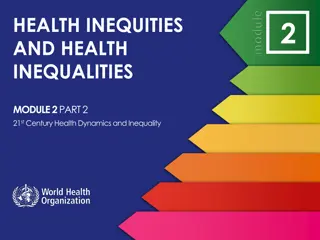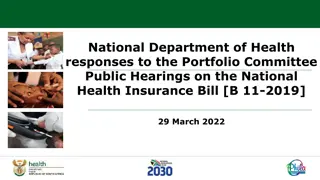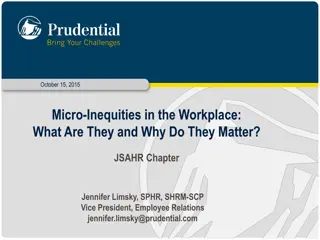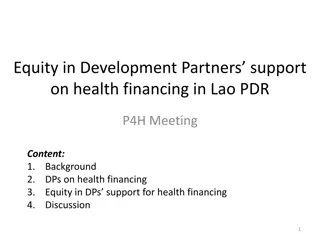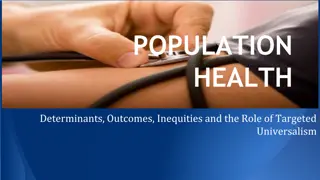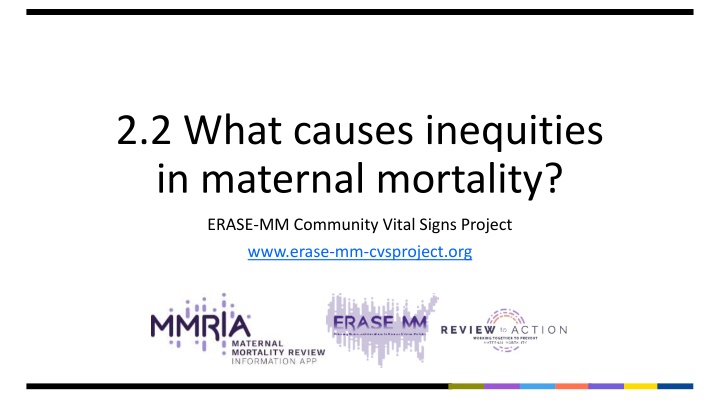
Inequities in Maternal Mortality and Their Causes
Discover the causes of inequities in maternal mortality, including racial disparities and geographic variations. Explore factors such as individual characteristics and socio-spatial data indicators impacting maternal health equity.
Download Presentation

Please find below an Image/Link to download the presentation.
The content on the website is provided AS IS for your information and personal use only. It may not be sold, licensed, or shared on other websites without obtaining consent from the author. If you encounter any issues during the download, it is possible that the publisher has removed the file from their server.
You are allowed to download the files provided on this website for personal or commercial use, subject to the condition that they are used lawfully. All files are the property of their respective owners.
The content on the website is provided AS IS for your information and personal use only. It may not be sold, licensed, or shared on other websites without obtaining consent from the author.
E N D
Presentation Transcript
2.2 What causes inequities in maternal mortality? ERASE-MM Community Vital Signs Project www.erase-mm-cvsproject.org
Pathway 1. MMRC Readiness Document # Document title 1.1 1.2 Is your MMRC ready to discuss health equity? Readiness checklist 2. Overview of the Community Vital Signs Project 2.1 2.2 What is the Community Vital Signs project? What causes inequities in pregnancy related mortality? 3. Using the CVS Dashboards 3.1 3.2 3.3 3.4 Understanding the data in the CVS dashboard Interpreting the CVS dashboard CVS Dashboard Cheat Sheet Retrieving CVS dashboards 4. Using the CVS Recommendations Reference 4.1 4.2 4.3 4.4 4.5 Using the CVS Recommendations Reference Overview of CVS Recommendation Reference Recommendation reference document, Part 1 (word) Recommendation reference detail table, Part 2 (excel) RWJF County Health Rankings Roadmap and Recommendations 5. For abstractors 5.1 5.2 Using the CVS dashboard for preparing case narratives Narrative template
Changing the conversation: ERASE-MM Community Vital Signs Project What are some causes of inequity? Socio-spatial data indicators CVS CVS Dashboard Recommendation Evidence-based conceptual model Provide Data Link to action
Changing the conversation: ERASE-MM Community Vital Signs Project What are some causes of inequity? Socio-spatial data indicators CVS CVS Dashboard Recommendation Evidence-based conceptual model Provide Data Link to action
Black and American Indian/Alaska Native pregnant people bear substantially greater burden Source: Petersen EE, Davis NL, Goodman D, Cox S, Syverson C, Seed K, et al. Racial/Ethnic Disparities in Pregnancy-Related Deaths United States, 2007 2016. MMWR Morb Mortal Wkly Rep. 2019 Sep 6;68(35):762 5. Image source: https://www.cdc.gov/reproductivehealth/maternal-mortality/disparities-pregnancy-related-deaths/infographic.html
Absolute rates and racial disparities are not constant but vary by geography Source: Petersen EE, Davis NL, Goodman D, Cox S, Syverson C, Seed K, et al. Racial/Ethnic Disparities in Pregnancy-Related Deaths United States, 2007 2016. MMWR Morb Mortal Wkly Rep. 2019 Sep 6;68(35):762 5. Image source: https://www.cdc.gov/reproductivehealth/maternal-mortality/disparities-pregnancy-related-deaths/infographic.html
What are individual level characteristics associated with pregnancy-related mortality? Advanced maternal age Underlying health status (e.g. obesity, hypertension, diabetes, heart disease) Mental health conditions and care Insurance status and attendance in prenatal care Individual socioeconomic status including education, occupation, and income
Individual factors are important but they do not explain disparities by race, class, or geography
Causes of death Causes of disparity Singh GK, Int Journal MCH, 2021 In US, age, socioeconomic status, education level, marital status, rural/urban are all associated with risk of maternal mortality Large Black-White racial disparities persist even within levels of other risk factors. High SES Black women have higher risk than low SES White women Gyamfi-Bannerman, et al, Am J ObGyn, 2018 National population-based study of severe morbidity and death among women with postpartum hemorrhage Racial disparities persist even after adjustment for socioeconomic status, insurance, and comorbidity index
Risk Regulators Fundamental Social Determinants Spatial & Social Population Stratification Contextual & Environmental Community Environment Behavioral Health Environment Transportation Environment Reproductive Health Environment Social Support Environment General Health Environment Opportunities Constraints Life course Embodiment Conception/early life Clinical Care Biomedical Kramer MR, Strahan AE, Preslar J, et al. Changing the conversation: applying a health equity framework to maternal mortality reviews. American journal of obstetrics and gynecology. 2019;221(6):609.e1-609.e9 Neuro- endocrine Health Immuno- inflammatory health Cardio metabolic health
Risk Regulators Fundamental Social Determinants Spatial & Social Population Stratification Contextual & Environmental Community Environment Behavioral Health Environment Transportation Environment Reproductive Health Environment Social Support Environment General Health Environment Opportunities Constraints Life course Embodiment Conception/early life Clinical Care Biomedical Kramer MR, Strahan AE, Preslar J, et al. Changing the conversation: applying a health equity framework to maternal mortality reviews. American journal of obstetrics and gynecology. 2019;221(6):609.e1-609.e9 Neuro- endocrine Health Immuno- inflammatory health Cardio metabolic health 1. Underlying health & pathophysiology
Risk Regulators Fundamental Social Determinants Spatial & Social Population Stratification Contextual & Environmental Community Environment Behavioral Health Environment Transportation Environment Reproductive Health Environment Social Support Environment General Health Environment Opportunities Constraints 2. Lifecourse Life course Embodiment Conception/early life Clinical Care Biomedical Kramer MR, Strahan AE, Preslar J, et al. Changing the conversation: applying a health equity framework to maternal mortality reviews. American journal of obstetrics and gynecology. 2019;221(6):609.e1-609.e9 Neuro- endocrine Health Immuno- inflammatory health Cardio metabolic health
Risk Regulators Fundamental Social Determinants Spatial & Social Population Stratification Contextual & Environmental Community Environment 3. Community Context Behavioral Health Environment Transportation Environment Reproductive Health Environment Social Support Environment General Health Environment Opportunities Constraints Life course Embodiment Conception/early life Clinical Care Biomedical Kramer MR, Strahan AE, Preslar J, et al. Changing the conversation: applying a health equity framework to maternal mortality reviews. American journal of obstetrics and gynecology. 2019;221(6):609.e1-609.e9 Neuro- endocrine Health Immuno- inflammatory health Cardio metabolic health
Risk Regulators 4. Fundamental Social Determinants Fundamental Social Determinants Spatial & Social Population Stratification Contextual & Environmental Community Environment Behavioral Health Environment Transportation Environment Reproductive Health Environment Social Support Environment General Health Environment Opportunities Constraints Life course Embodiment Conception/early life Clinical Care Biomedical Kramer MR, Strahan AE, Preslar J, et al. Changing the conversation: applying a health equity framework to maternal mortality reviews. American journal of obstetrics and gynecology. 2019;221(6):609.e1-609.e9 Neuro- endocrine Health Immuno- inflammatory health Cardio metabolic health
Risk Regulators Fundamental Social Determinants Spatial & Social Population Stratification Contextual & Environmental Community Environment Behavioral Health Environment Transportation Environment Reproductive Health Environment Social Support Environment General Health Environment 5. Embodiment Opportunities Constraints Life course Embodiment Conception/early life Clinical Care Biomedical Kramer MR, Strahan AE, Preslar J, et al. Changing the conversation: applying a health equity framework to maternal mortality reviews. American journal of obstetrics and gynecology. 2019;221(6):609.e1-609.e9 Neuro- endocrine Health Immuno- inflammatory health Cardio metabolic health
Contributing Factors (Page 2*) Added three new contributing factors*: Structural Racism Interpersonal Racism Discrimination
New Contributing Factors (Page 4*) Structural Racism: the systems of power based on historical injustices and contemporary social factors that systematically disadvantage people of color and advantage white people through inequities in housing, education, employment, earnings, benefits, credit, media, health care, criminal justice, etc. Adapted from Bailey ZD. Lancet. 2017; 389(10077):1453-1463.
New Contributing Factors (Page 4*) Interpersonal Racism: discriminatory interactions between individuals resulting in differential assumptions about the abilities, motives, and intentions of others and differential actions toward others based on their race. It can be conscious as well as unconscious, and it includes acts of commission and acts of omission. It manifests as lack of respect, suspicion, devaluation, scapegoating, and dehumanization. Adapted from Jones CP. Am J Public Health. 2000; 90(8): 1212 1215.
New Contributing Factors (Page 4*) Discrimination: treating someone more or less favorably based on the group, class or category they belong to resulting from biases, prejudices, and stereotyping. It can manifest as differences in care, clinical communication and shared decision-making. Adapted from Smedley BD. National Academies Press (US); 2003.
Conclusion 1. Understanding individual-level risk factors for health and risk in pregnancy is necessary but not sufficient to understand disparities 2. Aspects of the community social, service, and economic environment can shape the choices individuals make on a daily basis 3. Stronger and more impactful recommendations can be made by MMRCs if they can successfully identify structural, institutional, and interpersonal factors that contributed to a decedent s death
Acknowledgements The Community Vital Signs Project was developed by a team at Emory University with support from Centers for Disease Control and Prevention, Division of Reproductive Health Maternal Mortality Prevention Team Emory Team Michael Kramer (PI) Sarah Blake Autumn Watson Marissa Coloske CDC Team David Goodman Julie Zaharatos Toby Merkt Please use the Contact link at https://erase-mm-cvsproject.org to provide any feedback or ask questions This presentation was prepared by Michael Kramer





